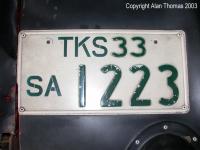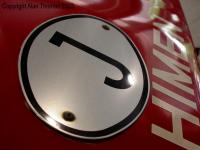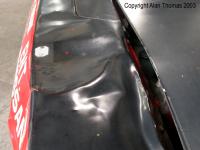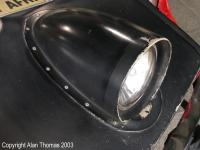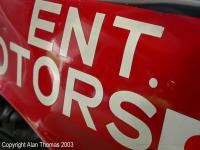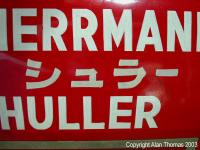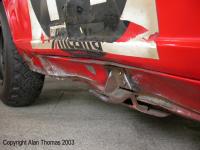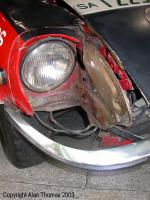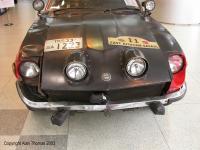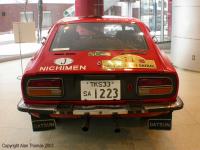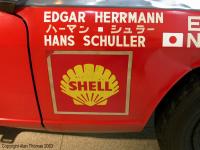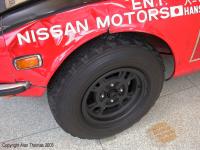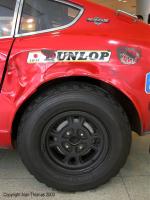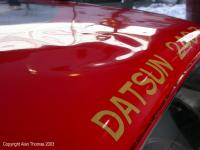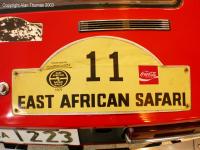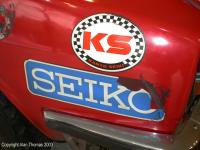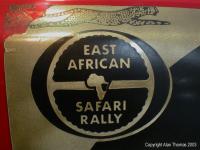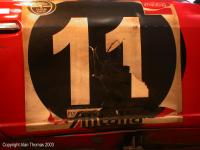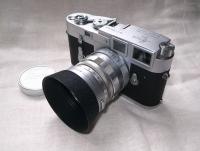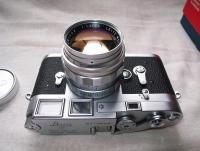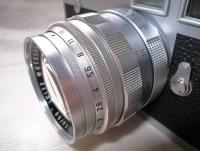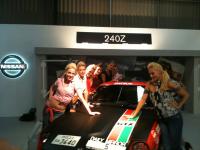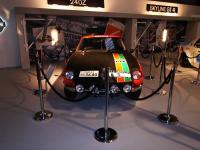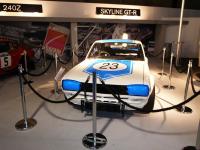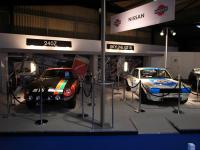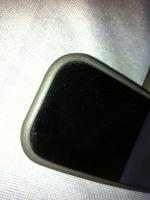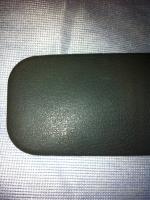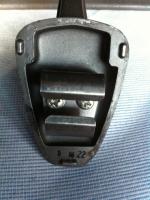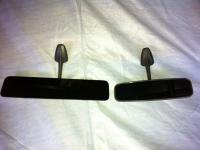Everything posted by HS30-H
-
JDM Headlight cover difference.
The point I was trying to make - and it's only a theory at this point, as I think we're all groping around in the dark so to speak - is that I noted E8726 following closely on the heels of E8725 ( the ZG type covers ), and the E8725 - in my experience - I have only ever seen in polished stainless ( never in chrome ). It seems likely to me that the E8726 would be stainless too.... The scenario I would expect ( especially comparing with other showroom 'Option' parts in Japan ) would be that more were sold over the counter - for retrofitting onto cars that were no longer new - than were chosen as extra-cost options on new cars. The second owners of cars, or even the original owners looking to add something to a car they bought new, would be likely to buy such items over the counter in the same way that they might buy some aftermarket nick-nacks, to give the car a fresh look or feel. Not forgetting of course that the headlamp covers were available for many years longer than the actual cars were..... And also, if your car had covers, and one or both of them got damaged or tired / faded, then what did you do? If you took them off, you had an unsightly mess of holes to look at ( three for each mounting screw ). You'd either need to buy another set of covers, or have some localised repairs and paint. No wonder Nissan kept making them for a long time. Alan T.
-
JDM Headlight cover difference.
Ron, Have you noticed that the change to the E8726 suffixes coincides with the introduction of the L24-engined models to the Japanese market, and therefore the introduction of the 'HZG' variants? Fairlady 240ZG ( HS30-H / HS30-HA & 'HZG' / 'HZGA' ) models used 63900-E8725 ( RH ) & 63901-E8725 ( LH ) headlamp covers, which were - of course - the longer type, to fit the 'Grande' nose. In my experience, all the original ZG type headlamp covers I have come across have been made from stainless steel, and - generally speaking, as I've had a lot of them pass through my hands - the earliest 'short nose' covers ( and therefore probably E4126 suffixed ) have been chromed steel, and the known-to-be 'later' ones ( likely E8726 suffixed? ) have been polished stainless. Therefore, 'Zenki' type = chrome, 'Kouki' type ( after introduction of ZG ) = stainless....? PS: What I'm saying is that the different part number suffix doesn't necessarily indicate the change in mounting hole location...... Alan T.
-
Pedegree of S30 styling?
You could read it as some kind of Newtonian equal and opposite reaction to reading / hearing mistakes, untruths and plain lies. If people keep saying that Goertz designed / styled the S30 ( and the Toyota 2000GT ) and all that other stuff, then I'm afraid people like me are going to pipe up to try and get it straightened out. Tilting at windmills perhaps, but worth taking a shot at, in my opinion. One phenomenon I sometimes come across - and which surprises me every time I see it - is where people seem to want to connect Goertz to the cars, but then profess not to care who was actually responsible when the Goertz story is so easily dismissed. It's almost like the Japanese people responsible don't deserve to have their names mentioned. Papa Smurf? Hmmmm. That might just be a very revealing comment. I beg to differ, of course. But can you tell me why you would say that, and indeed why you would go to the trouble of posting it if you really don't care? Cheers, Alan T.
-
Pedegree of S30 styling?
Marco69, No offence, but.... No they didn't. To be blunt, there are no such "facts". What magical 'sketch' is this, then? The real hands-on protagonists in the stories of both the S30-series Z and Toyota's MF10 have all made it clear that Goertz was not behind their designs. The only person who claimed such influence was Goertz himself, and his claims were not based on any substance. They are - quite simply - not true. This is not what happened. You are confusing the story of the 'Nissan 2000GT' / 'Nissan A550X' Yamaha prototype with the stories of the Nissan S30 and Toyota MF10. There is no direct lineage between the three designs. Not a single line or curve on, or in, the S30 and MF10 can be attributed to Goertz. It's that simple. Please don't be offended, but I believe sometimes it's worth being forceful about such things. People seem to want to believe the Goertz stories, but they are based on little more than his own hubris. It really is time for us to give the credit to the people who deserve it. We are closer to the truth right now than we have ever been in the past. Alan T.
-
Datsun-240z Vs Fairlady-z432
Mike, I certainly didn't dream it all up on my own after eating too much cheese before bedtime. As Kats points out, the early Japanese market parts lists don't show the "untint" clear glass of the 'Z-Std' / S30-S, but early models certainly featured clear, untinted glass. I believe that this is just another omission from the parts lists, and that later 'Z-Std' models ( although I don't know how late ) received tinted glass in much the same way as they suddenly received the dipping mirrors. I wonder if this was some kind of rationalisation measure? If you compare the S30-series Z to other contemporary Nissan models like the C10 Skyline, the 'Std' or most basic models often had clear, untinted glass whilst the 'Dx' models got tinted. Also, GT-R models of the C10 Skyline range got clear glass, no doubt as part of their 'pure driving' image. I'm fairly sure I have an early 1970 Japanese magazine road test which mentions the clear glass of the Std model. I shall see if I can find it again. Alan T.
-
3 view blueprints
Apart from a few small details ( EG fender mirrors, RHD wiper orientation ), this might be of more use to you:
-
Master Brake hose for Series 1 Needed!
Esprist, It might be worth clarifying that these repro Master Vac hoses will be for LHD applications, and that they will not work with RHD cars. Cheers, Alan T.
-
1971 East African Safari Rally
You're welcome, Mike. Here are a few more, this time taken when the car was on display at Nissan's old Ginza, Tokyo HQ:
-
1971 East African Safari Rally
-
1972 Fairlady Z for sale
Aha, I see what you mean. I was looking around for anything obviously missing rather than damaged / hacked off. Shame about the sunroof, and to a lesser extent the side trims and re-upholstery job. Other than that it seems like a nice honest example that's 'had a life'......
-
1972 Fairlady Z for sale
Looks like an L20A to me ( judging from the scale of the carbs, they look like HJG38s ). What makes you think its "2.4L" from the photos, and what part is it missing "from the rear"?
-
Anyone else into cameras and photography?
One for the hardware fans, perhaps: Until just a few days ago, I had this sitting on a shelf in my office. A beautiful thing. Ironically, these photos of it were taken with my little Ricoh GR Digital II, which is what I tend to grab anytime I think I'm going to need a camera. I have a Nikon D70 too, but somehow it seems to get in the way when I'm carrying it around and I always feel like I'm going to bash it or drop it.
-
Who actually did S30's styling? We can make it clear
Ian, Just to make it clear for anybody who hasn't seen that Nos. Hero article, the whole point of the article is that Goertz didn't design the CSP311 Silvia Coupe. The article - which, as you point out, Kimura co-operated with - shed some light on the fact that Kimura and others had all but finalised the design and styling of the CSP311 a good while before Goertz had got his foot through the door at Nissan. The only major change after Goertz turned up was the slight re-shaping of the rear pillars.... I believe Yamaha finished the first CSP311 prototype before the 15th October 1963 deadline that they had been given, but that Nissan decided not to show it at that year's Tokyo show? I have a big hunch that there's still more of the A550X story to be revealed, and that - given his track record - we can't trust a single word that Goertz ever uttered about his time with Nissan / Yamaha / The Yasukawa Institute. Alan T.
-
Day/night feature on Euro rearview mirrors?
I know what you mean, Chris. But what about this mysterious mirror of Mike B's with the 96321-E8300 number on the box? How would a late 1971 production date make sense for that to actually be a 96321-E8300 mirror? We can see that Mike's mirror is clearly different to the early type non-dipping mirror ( 96321-E4100 ), so why two different non-dipping mirrors at the same period of production? If it were a mirror from a Sunny, Bluebird or Skyline that accidentally got put in an E8300 box ( or if the real E8300 from that box is now on a car, and the mirror in the box is what it replaced... ) then it would all make a little bit more sense to me. The update from E4600 to E4601 seems to make sense too, and occurs across more than one market so we can cross-reference a little. E8300 only seems to make sense to me if it is a dipping type..... Sorry to be so tenacious, but it would be nice to get to the bottom of this and I just don't 100% trust what I find in 'NOS' boxes anymore!
-
Let's show vintage racing pictures. I'll start.
...Until the owners turned up and spoiled it Kevin's car got attacked by a bunch of over-enthusiastic visitors. Fingerprints all over the car. Took ages to take all their phone numbers....
-
Day/night feature on Euro rearview mirrors?
Sorry Mike, what I was trying to get at was the full part number ( 96321 - E8300 ), not just the E8300, doesn't seem to appear until later than the inspection stamp on your mystery mirror ( I'm still not convinced that it's a 96321 - E8300 anyway... ). We have non-dipping ( E4100 ) and dipping ( E4600 & E4601 ) type part numbers for the first few years of production, so an E8300 part number would need to indicate yet another part detail difference. I'm not sure I understand the difference between the E4600 & E4601 at this point either. They both appear to be dipping type, so what difference? Is it a glass tint, glass type ( safety glass? ) or dipping 'knob' difference? Yes I take your point, and I agree that there are lots of mistakes in the parts lists - so we should be careful. That E4100 listing in the USA / Canada list might have been a typo ( should have been E4600? ). Yes, I think the 'IKI 8006' stamping relates to the glass & housing rather than the whole part. I've seen similar mirror housings, but with different stalks ( for different models ). No photos I'm afraid ( didn't know I was going to be asked for proof...! ) but it seems to make sense to me. I think that 'E' mark on jerz's mirror would - at the very least - indicate that it needed to have a different part number than your mirror. If Nissan had two different versions of the same part, but used the same part number for both, then it would not make sense if one of them complied with Euro NCAP legislation. It would be all too easy to fit the non 'E'-marked part to a car that needed to have the 'E' mark. If it were simply a case of 'early' and 'late', it would again need an updated part number to avoid the 'early' part being fitted where the 'late' type was legally required. I concede that your 'mystery' mirror might well indeed be a 96321 - E8300, but if it is, then I don't think jerz's mirror is a 96321 - E8300 too..... Alan T.
-
Let's show vintage racing pictures. I'll start.
Whilst you were at the 2010 Goodwood Revival Meeting, did you venture into the 'Earls Court Motor Show' building? Kevin Bristow's works 1971 RAC Rally 240Z was on display, and my KPGC10 Skyline GT-R was next to it. Our cars were guests on the Nissan show stand:
-
Day/night feature on Euro rearview mirrors?
Jeremy, My gut feeling is that this must have been a very late safety legislation-related issue. Those 'E' marks on the back of your mirror make me think Euro NCAP..... As I wrote earlier, the first European 2+2 models had the E4601 ( listed as from October '73 ), but I don't know the applied date for the N3500. Maybe we could find out somehow? Kats, Thanks for confirming the E4100 details, and posting the photos. I guess a lot of original 432-R owners chose to have the dipping mirror instead of the standard non-dipping, and now there's a shortage of the 'correct' E4100 type to reverse that.... Behold, some ( disappointing quality ) I-Phone photos from my garages this evening: E4100 type non-dipping mirror ( with characteristic textured finish on the back ) and one of the super wide repro Nissan 'Race Option' GT-R / 432-R non-dippers:
-
Day/night feature on Euro rearview mirrors?
Look in to my eyes. Trust me. You are feeling veeeeerrry sleeeeeepy. E4100 IS A NON-DIPPING MIRROR!. Click. You're back in the room. Agreed. That "Automatic" trans only application from the USA & Canada parts list is slightly bizarre, and not to be trusted. However, we have no choice but to refer to these documents and place a certain amount of trust in them. What other choice do we have? I think we simply have to try to spot the anomalies like this one, mark them on our maps, and steer around them. Have you got anything earlier than a 1973 document that mentions the E8300 number? My point is that it seems to me to be a later part number than the Aug. '71 production stamp on the item you have. I have a hunch that it's at least late '72 onwards. To my mind, that mis-match is consistent with my conviction that the E8300 mirror was a dipping type mirror anyway. If you look at the earliest R-Drive parts lists ( although my earliest R-Drive Export parts list is "Revised March 1973" ) you see both the E4100 and E8300 listed ( "Exc. Europe" and "Europe" respectively ). Since I know ( from the Japanese market parts lists ) that the E4100 is the basic non-dipping type, it follows - for me anyway - that the E8300 must be a dipping type. If it were not, then that particular R-Drive parts list would not list a dipping mirror.... Looking at the other export 'R-Drive' parts list I have ( this one "Revised March 1974" ) it lists only the E4601 for both the 2-seater and 2+2 models ( 2+2 given as "from Oct. '73" ). That seems to tie in with what happened in the Japanese market: Earliest Japanese market parts list lists the E4100 for the 'S' model ( the basic S30-S model Fairlady Z, known internally at Nissan as the 'ZS' or 'Z-Std' ), and although it doesn't list it specifically in this parts list, this was also fitted to the stripped-out Z432-R model ( it was noted in later parts lists ). That non-dipping mirror ties in with the spartan ethos of those two models. The other mirror in the list is the E4600, which we know is the dipping type, and which was listed as standard eqpt. for the 'D' model ( 'Deluxe' model S30 Fairlady Z-L ) and 'P' model ( PS30 model Fairlady Z432, which shared the 'Deluxe' spec trim of the 'D'. Second Japanese parts list quotes the E4601 ( a dipping mirror ) as replacing both the E4100 and E4600 for ALL Japanese market models from September 1972 onwards, and I believe this ties in with some new Japanese legislation that was brought in at that point. Safety glass for interior mirrors? The non-dipping mirror fitted with the spartan, stripped-down ethos of the 'S' and 'PZR' models. They just had less bells and whistles than their more expensive model range siblings. This was consistent with other models in the Nissan lineup ( Sunnies, Bluebirds, Skylines etc etc ) where the cheaper, less highly appointed variants also had non-dipping mirrors. As IKI were making these for Nissan anyway, it doesn't necessarily follow that it cost Nissan more to have both dipping and non-dipping mirrors for different variants of the S30 series. So, I can imagine somebody choosing to pay some extra and 'upgrade' from a stock fitment non-dipping mirror on an ZS or PZR to a dipping type ( dipping function is useful ) but I find it hard to imagine anyone purposely downgrading from dipping to non-dipping. No, that's a completely different thing. They were 'Race Option' mirrors, offered for the GT-R and 432-R ( well before NISMO ) and are huge. Almost twice as wide as the standard mirrors. I have one on my KPGC10, and you can see the whole of the back window in it, as well as most of both rear pillars! I'll take a photo of it next to that E4100 I have. Bear with me.... Alan T.
-
Day/night feature on Euro rearview mirrors?
I still say that it doesn't look like the early ( E4100 ) non-dipping mirror, and the N3500 and E8300 part numbers don't appear to match with a 1971 inspection stamp. IKI supplied similar mirrors for other Nissan models, so I wouldn't put too much faith in the numbers stamped on the back of the mirror housing. I still feel unsure that your mirror is in the correct box ( which would appear to be the only thing linking it to the E8300 part number at this point - yes? ) and a couple of other things don't seem to add up either. I believe E8300 is the dipping type. As I wrote before, the dipping type ( "glare proof" ) mirror was fitted as standard equipment in Europe and the UK, at least until late into production. You see them in the road tests, in the sales literature and on the cars that are still around. I don't know why anyone would choose to have a non-dipping type as an option when the dipping type was standard ( who would even think of something as trivial as that, and what benefit would there be in having the non-dipping type when the dipping type worked in two ways anyway? ), so I'm wondering if this was a late safety legislation issue in a particular territory? That 'E' mark on jerz's mirror would appear to point towards something like that. jerz's scan of the late R-Drive parts list shows that the E4100 was "EXC EUROPE". That means it wasn't offered as standard eqpt. on European market cars. No, that would be the E4100 and if the b/w picture shows an S30-S 'Z-Std' no-frills model or a PS30-SB 'Z432-R' model then that would make sense. I don't believe that's what you have in your box. I have an E4100 in storage in my garages. I shall take some photos of it tomorrow and put them up here. Alan T.
-
Day/night feature on Euro rearview mirrors?
Mike, As far as I am aware, all 'European' market models had a dipping interior rear view mirror as standard equipment. UK models did too. I think you are correct about the manufacturing date on the mirror itself, but I don't feel that the part itself looks like what should be in that box ( if you know what I mean ). Your mirror doesn't look anything like the non-dipping mirror ( 96321 - E4100 ) seen on the S30-S ( 'Z-Std' ) and PS30-SB ( 'PZR' ) either. Could it be a case of the part not matching up with the box? Contents switched in the past? The hand written 'HLS30 U' doesn't seem to match up with what's in the box or the part number. I've got a vague recollection that there was a difference in glass tint on one version of the dipping mirrors ( hence a different part number ), but I can't remember much more than that... Alan T.
-
1970 Engine?
Yes Kats, casting is first, but second comes machining. Some engine blocks could end up being machined and quality-control passed a fair time after they were originally cast, and they would not be stamped with their unique serial number until after this had all been finished. Such a scenario is also the explanation for the seemingly 'early' casting dates on the S20 engine blocks seen in the first 432s and 432Rs. Nissan started casting S20 engine blocks for the PGC10 Skyline GT-R, knew that they needed some for the planned 432s and 432Rs, and simply cast them at the same time. They would not receive their stamped serial numbers until they had been machined and/or assembled. 432 / 432R-specific S20 engines were of course different to GT-R-specific S20 engines in that they were machined differently. This because of their differing sump / oil pump pickup / dipstick layouts. Once they had been machined, they were either GT-R or 432 / 432R specific, and could not be confused. Alan T.
-
Kobe Seiko Rally Wheels on Ebay
I'll send you a PM with the contact details, but - as far as I am aware at present - all wheels in both the 14" and 15" version are sold out. They might make another batch, so it's worth contacting them to put your name down for a set.... Cheers, Alan T.
-
Datsun-240z Vs Fairlady-z432
NismoZ, I think you're very unlikely to find a complete S20 engine for what you consider to be a "decent price". The scarcity of the engines and their specific components, along with the increasing prices of the cars that they were originally fitted to, means that people who have spare engines are tending to hold on to them or only sell them for high figures. I think you'd struggle to find a complete, rebuildable core engine for anything less than 1.5 million Yen. If you did find one, it will most likely be from a C10-series Skyline ( C110-series being fairly unlikely ) and not from a PS30 or PS30-SB model. Therefore, you'd need to source the 432-specific sump, oil pickup, oil pump extension and engine mount brackets. Any used S20 engine you buy will almost certainly need a complete rebuild. They are exponentially more costly to rebuild than an L-gata. The price of a new S20 water pump - for example - would make your eyes water. As 26th-Z mentioned, the FS5C71-A transmission was used - but with the S20-specific bellhousing, which is nothing like the 'Roadster' or L-series bellhousings. Later cars used the FS5C71-B transmission, but again this used an S20-specific integral bellhousing / front case. They are not cheap, I'm afraid.... As for fitting the engine, you'd need to fabricate the S20-specific front crossmember ( taller engine mount 'towers' with a different angle to them ) and address the issue of the lack of space on the exhaust side of an LHD installation. You'll be building a fairly tortured exhaust manifold to clear the steering gear and master cylinders, and S20 engines are very sensitive to manifold shape and sizing. As for power and bang-for-buck, it's no contest. Stock for stock the S20 wins, but start tuning and upgrading and the L-gata leaps ahead due to extra swept volume, the possibility to swap components, and the relatively cheap tuning parts available for it. You can build a BIG power S20 ( long stroke crank, bigger pistons and liners ) but you top out around 2300cc and 280ps, and it costs an absolute fortune. It also becomes a typical small capacity 'race' type NA engine in that it needs to operate within a narrow rev range to produce its power, which limits driveability. So, to cut a long story short, give up now Alan T.
-
Where does this car come from?
That's a United Kingdom registration plate, and the letter 'S' suffix indicates original registration was between 1st August 1977 and 31st July 1978.






